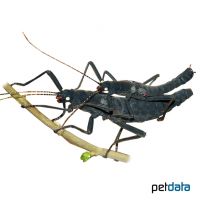Black Beauty Stick Insect (Peruphasma schultei)
| Black Beauty Stick Insect Peruphasma schultei | |
|---|---|
| Name | Black Beauty Stick Insect |
| Name Lat. | Peruphasma schultei |
| Family | Striped Walkingsticks |
| Family lat. | Pseudophasmatidae |
| Order | Phasmids |
| Order lat. | Phasmatodea |
| Origin | Peru |
| Habitat | Tropical forest |
| Diet | Privet, lilac leaves |
| Humidity | 40-60 % |
| Behavior | Nocturnal, peaceful |
| Keeping | Pair, group |
| Care Level | Easy |
| Housing | Semi-humid terrarium |
| Breeding | Simple |
| Life Span | 1-2 years |
| Protection | No |
| Metric Units | |
| Size | 4-7 cm |
| Temperature Day | 20-26 °C |
| Temperature Night | 18-20 °C |
| Housing Size | 30 x 30 x 50 cm |
| US Units | |
| Size | 1.6"-2.8" |
| Temperature Day | 68-79 °F |
| Temperature Night | 64-68 °F |
| Housing Size | 10" x 10" x 20" |
Distribution and habitat
The nocturnal velvet grasshopper is found exclusively (endemically) in the Cordillera del Condor, a small-scale mountainous area in northern Peru, where it lives primarily in the branches of the evergreen Peruvian pepper tree at altitudes of about 1200 to 1800 m.
Maintenance
We recommend an insectarium of at least 30 x 30 x 50 cm (L x W x H) for a small group (2-3 pairs), which should be placed in a quiet place without sunlight.
The most suitable is an insectarium with a cover made of gauze or a fine metal grid, which should be placed in a quiet, place without sunlight.
They need climbing facilities, such as cork backs, twigs and branches, which also serve as food plants. To keep them fresh longer, they should be served in narrow-necked, well-sealed (danger of drowning), stable containers (e.g. vase). Furthermore, a small, shallow drinking vessel with water gel or a cotton trough. Suitable substrate is terrarium humus or a soil-sand mixture covered with moss, which should always be kept slightly moist. Several times a week, preferably in the evening, the inside of the insectarium should be finely sprayed with water (humidity), but a rain or mist system is better. Too high humidity and waterlogging should be avoided at all costs. Good ventilation is especially important
| Temp. day: 20-26°C | Temp. night: 18-20 °C | Humidity: 40-60 |
The lighting duration should be 10-12 hrs. Light sources that also produce the necessary heat are ideal.
Diet
In the wild, they feed primarily on the foliage of the Peruvian pepper tree (Schinus molle)
The food supply consists of fresh leaves of privet, lilac, forsythia, etc. Cherry laurel, ivy and ash are also accepted with individual variation. Evergreen plants are ideal as food in winter. Eaten branches, dried or spoiled foliage must be removed regularly.
A regular and varied diet promotes the well-being of the animals.
Reproduction and breeding
The females grow slightly larger than the somewhat slimmer males. Both sexes have the same coloration.
After the often long lasting mating the female lays about 3 mm long eggs. At 25-27 °C the approx. 15 mm long nymphs hatch after about 4-5 months. They feed on the same food as the adults. After 3-4 months they are fully grown
After the imaginal molt, females are ready to mate after about 14 days. Females reach an age of up to 2 years, males live only about 9 months.
Important
The velvet cricket was only discovered in northern Peru in 2004.
When threatened, velvet grasshoppers can spray a foul-smelling defensive secretion of stomach acid, which can cause irritation of the mucous membranes.
Before purchasing, a terrarium should be prepared that meets the species specific needs. Necessary is good ventilation without drafts, as well as equipment for measuring temperature and humidity. The lighting has to correspond to the species-specific day-night rhythm and has to be placed in such a way that the animals cannot injure themselves
The terrarium should be locked in such a way that neither unauthorized persons can open it nor the animals can escape. Special attention must be paid to thorough hygiene and impurities must be removed regularly
Further literature can be found in your pet store
References
Text: Serena Werle; Image: petdata
Source: ENGELMANN & LANGE (2011): Zootierhaltung - Tiere in menschlicher Obhut: Wirbellose, Harri Deutsch Verlag; HENKEL & SCHMIDT (2010): Taschenatlas Wirbellose für das Terrarium, Verlag Ulmer
